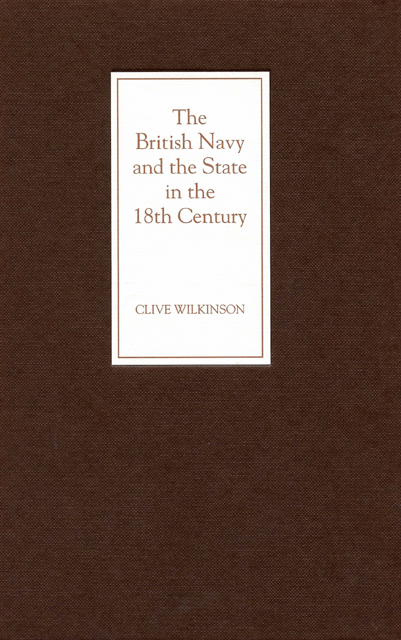Book contents
- Frontmatter
- Contents
- Foreword
- Acknowledgements
- Abbreviations
- 1 The Myth of a Paper Fleet
- 2 Government and the Navy
- 3 ‘Treating the House with Contempt’: British Naval Finance in the Eighteenth Century
- 4 Crisis and Victory: The Navy, 1714–62
- 5 The Peace Establishment I: Demobilization and Retrenchment, 1763–6
- 6 The Peace Establishment II: Stability, Innovation, and the Falklands, 1766–70
- 7 Sandwich, Parliament and the Paper Fleet, 1771–9
- 8 Conclusion
- Appendix 1 Extraordinary Estimates 1750–76
- Appendix 2 Extraordinary Estimate, Navy Office, 2 February 1767
- Appendix 3 Estimate of Monies Needed (ADM B 177, 5 August 1765)
- Appendix 4 ‘Plan of Expense of His Majesty’s Navy for the Year 1768’ (ADM B 181, 27 May 1768)
- Appendix 5 Account of the Course of the Navy (Fragment, ADM B 183, 6 August 1770)
- Appendix 6 A List of the Ships of the Royal Navy, 1 January 1763, with the Condition of the Navy on Survey (ADM 7 553)
- Appendix 7 British Battlefleet 1714–80
- Appendix 8 Environmental Impact on the Navy’s Ships, 1710–80
- Appendix 9 Naval Finance and Expenditure
- Appendix 10 The Procedure for Voting a Supply to the Navy
- Bibliography
- Index
6 - The Peace Establishment II: Stability, Innovation, and the Falklands, 1766–70
Published online by Cambridge University Press: 18 March 2023
- Frontmatter
- Contents
- Foreword
- Acknowledgements
- Abbreviations
- 1 The Myth of a Paper Fleet
- 2 Government and the Navy
- 3 ‘Treating the House with Contempt’: British Naval Finance in the Eighteenth Century
- 4 Crisis and Victory: The Navy, 1714–62
- 5 The Peace Establishment I: Demobilization and Retrenchment, 1763–6
- 6 The Peace Establishment II: Stability, Innovation, and the Falklands, 1766–70
- 7 Sandwich, Parliament and the Paper Fleet, 1771–9
- 8 Conclusion
- Appendix 1 Extraordinary Estimates 1750–76
- Appendix 2 Extraordinary Estimate, Navy Office, 2 February 1767
- Appendix 3 Estimate of Monies Needed (ADM B 177, 5 August 1765)
- Appendix 4 ‘Plan of Expense of His Majesty’s Navy for the Year 1768’ (ADM B 181, 27 May 1768)
- Appendix 5 Account of the Course of the Navy (Fragment, ADM B 183, 6 August 1770)
- Appendix 6 A List of the Ships of the Royal Navy, 1 January 1763, with the Condition of the Navy on Survey (ADM 7 553)
- Appendix 7 British Battlefleet 1714–80
- Appendix 8 Environmental Impact on the Navy’s Ships, 1710–80
- Appendix 9 Naval Finance and Expenditure
- Appendix 10 The Procedure for Voting a Supply to the Navy
- Bibliography
- Index
Summary
The naval administration of the Earl of Egmont ended in September 1766. He left a fleet that had undergone substantial and rapid repair and was quickly approaching the level, in terms of numbers of ships, needed to secure Britain’s maritime interests. The dockyards had also undergone a number of important reforms, increasing their efficiency and productivity. Two peacetime administrations followed that of Egmont; the short three-month service of Admiral Sir Charles Saunders and then the administration of Admiral Sir Edward Hawke. Toward the end of Hawke’s tenure at the Admiralty, a crisis arose with Spain over the Falkland Islands during which, on mobilization, some of the Navy’s ships were found unfit for service. During the first years of the subsequent naval administration, Lord Sandwich ordered a number of surveys by which it was discovered that a substantial part of the fleet was in no condition for service in the event of war. The fine fleet Sandwich inherited from Hawke was apparently a paper fleet and Hawke was later criticized to such an extent that he felt obliged to defend his conduct in print.
Reasons for such a rapid deterioration of the fleet will be explored in the next chapter. Here it will be shown that the period between the administrations of Egmont and Sandwich was one in which the affairs of the Navy were managed in a competent manner and that Hawke and his colleagues were no more guilty of neglect than Egmont was. It was in fact a period of continued improvements in efficiency and one of considerable innovation and reform. Much of the reform was in the area of finance and appropriation. The Navy was adequately funded yet kept largely within the government’s policies of economy by savings made through efficiencies, and by good financial management. A particularly shrewd appointment, Charles Jenkinson, was made to the Admiralty Board which assisted these objectives. This in itself was an innovation, considering the importance of these posts in terms of political patronage. The alleged poor condition of the fleet in 1770 at the time of the Falklands Crisis was greatly exaggerated although, as the 1770s progressed, it was plain that a considerable problem was unfolding.
Saunders and the Admiralty, 1766
Vice-Admiral Sir Charles Saunders replaced Egmont at the Admiralty on the latter’s resignation. He was a naval officer of some distinction and he had already served as a Commissioner of the Admiralty for over a year.
- Type
- Chapter
- Information
- The British Navy and the State in the Eighteenth Century , pp. 139 - 164Publisher: Boydell & BrewerPrint publication year: 2004

